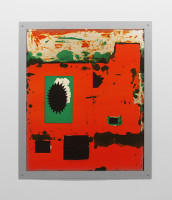JTF (just the facts): A total of 10 photographic works, mounted and unframed, and hung against white walls in the main gallery space and the entry area. 7 of the works are gelatin silver photograms mounted on black sintra, made in 2018. Each is sized roughly 76×48 inches and is unique.
The other 3 works on view are dyed gelatin silver photograms with collaged layers, mounted on color coordinated sintra, made in 2018. Physical sizes of these works range from roughly 22×19 to 27×22, and all of these works are unique.
Comments/Context: As global climate change strengthens the storms that batter the Atlantic coast during hurricane season, images of hasty preparations made as the clouds begin to threaten have become an all too common news item. We watch anxiously as people tie things down, board up openings, stand in blustery winds looking at the threatening sea, and then load their belongings into cars and head off to evacuation centers, the raincoats, rubber waders, and rowboats left at the ready if (and usually when) the surging waters rise too far.
One repeated visual motif of hurricane preparation is the taping of large plate glass windows. Homeowners use tape to try to brace their windows against the harsh winds, the theory being that the tape will help prevent the windows from shattering or being blown in. The reality is that this taping doesn’t really improve the likelihood of having windows stay intact during a storm, and actually potentially makes windows that do break more dangerous by keeping larger shards together. But against all advice to the contrary, people continue to tape their windows when the alerts come in, the effort perhaps providing the comfort of doing something to counteract the unforgiving wrath of Mother Nature.
While Aspen Mays now lives and works in San Francisco, her hometown of Charleston, South Carolina, sits right in the busy path of the usual East Coast hurricane flow. Hurricane Hugo (from 1989) remains fresh in her memory via an archive of images and newspaper clippings she has gathered from that particular storm, and on the eve of this show, Hurricane Florence attacked the region with yet another round of devastating force and destruction.
Mays has been experimenting with complex photogram techniques for years now, and her newest projects leverage that process-centric experience in works that engage with these hurricane-related themes. Large-scale black and white works use the windows of a Charleston restaurant (as they appeared in a Hugo-era newspaper clipping) as a starting point, the arched openings becoming the backdrop for Mays’ own aesthetic improvisations.
Using a painstaking set of projection, transparency, and masking techniques, Mays fills the voids with different taping patterns (at one-to-one scale with actual tape sizes), the emptiness of the enveloping darkness covered by xes, asterisks, starbursts, and other tape forms. Up close, the threading of the transparent tape becomes visible and tactile, as does the slight misalignment of the masks, cutouts, and overlayers that make up her art-making process, creating edges of bright white underneath strips of black.
Conceptually, the plucky, playful appearance of these temporary window patterns of course disconnects from their purpose, the ultimate futility of the gestures when matched by the overpowering ferocity of the winds and waves making these recreations all the more fragile and sad. Mays’ work has often included looks upward to the stars and at the immensity of the universe, and these works recall those themes and aesthetic motifs of mismatched size, albeit at a much more human scale.
A small group of three brightly-colored works provide an alternate, and less fully formed, path into these hurricane ideas. Here Mays uses the eye-popping colors of the Doppler weather radar, particularly the insistent reds and oranges that tend to lie at the center of intensity, to dye her photograms. These works are much less literal than the taped windows, blending gestural chemical washes with more discrete icon forms (starbursts again), painterly marks, and even some collaged elements. Compared with the muted monochrome tones of the windows, these works are positively eye-popping, but their artistic message is far more diffuse, falling quickly toward process-centric forms of abstraction.
Artworks about climate change have often suffered from an arms-length kind of obviousness, where the sun bakes, blizzards blow, and huge waves crash, but in ways that we have sadly become numb to. Mays actively tries to pull back to something more indirect and personal, and that intimate thinking gives these works their resonance. Her taped windows feel deeply physical, the stretch of the arm necessary to lay the tape down hanging in the air around us. But the hopeful folly of the activity adds a darker layer of emotion to the works, the doom that lies beyond the frame that much more ominous.

